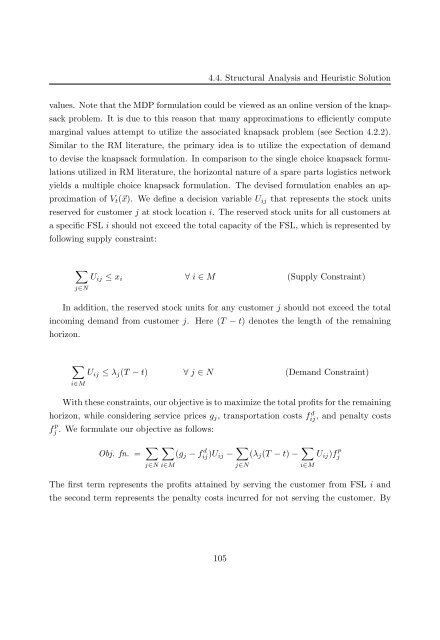Customer Information Driven After Sales Service ... - RePub
Customer Information Driven After Sales Service ... - RePub
Customer Information Driven After Sales Service ... - RePub
Create successful ePaper yourself
Turn your PDF publications into a flip-book with our unique Google optimized e-Paper software.
4.4. Structural Analysis and Heuristic Solution<br />
values. Note that the MDP formulation could be viewed as an online version of the knapsack<br />
problem. It is due to this reason that many approximations to efficiently compute<br />
marginal values attempt to utilize the associated knapsack problem (see Section 4.2.2).<br />
Similar to the RM literature, the primary idea is to utilize the expectation of demand<br />
to devise the knapsack formulation. In comparison to the single choice knapsack formulations<br />
utilized in RM literature, the horizontal nature of a spare parts logistics network<br />
yields a multiple choice knapsack formulation. The devised formulation enables an approximation<br />
of Vt(�x). We define a decision variable Uij that represents the stock units<br />
reserved for customer j at stock location i. The reserved stock units for all customers at<br />
a specific FSL i should not exceed the total capacity of the FSL, which is represented by<br />
following supply constraint:<br />
�<br />
Uij ≤ xi ∀ i ∈ M (Supply Constraint)<br />
j∈N<br />
In addition, the reserved stock units for any customer j should not exceed the total<br />
incoming demand from customer j. Here (T− t) denotes the length of the remaining<br />
horizon.<br />
�<br />
Uij ≤ λj(T − t) ∀ j ∈ N (Demand Constraint)<br />
i∈M<br />
With these constraints, our objective is to maximize the total profits for the remaining<br />
horizon, while considering service prices gj, transportation costs f d ij , and penalty costs<br />
f p<br />
j . We formulate our objective as follows:<br />
Obj. fn. = � �<br />
(gj − f d ij)Uij − �<br />
(λj(T − t) − �<br />
j∈N i∈M<br />
j∈N<br />
i∈M<br />
Uij)f p<br />
j<br />
The first term represents the profits attained by serving the customer from FSL i and<br />
the second term represents the penalty costs incurred for not serving the customer. By<br />
105

















